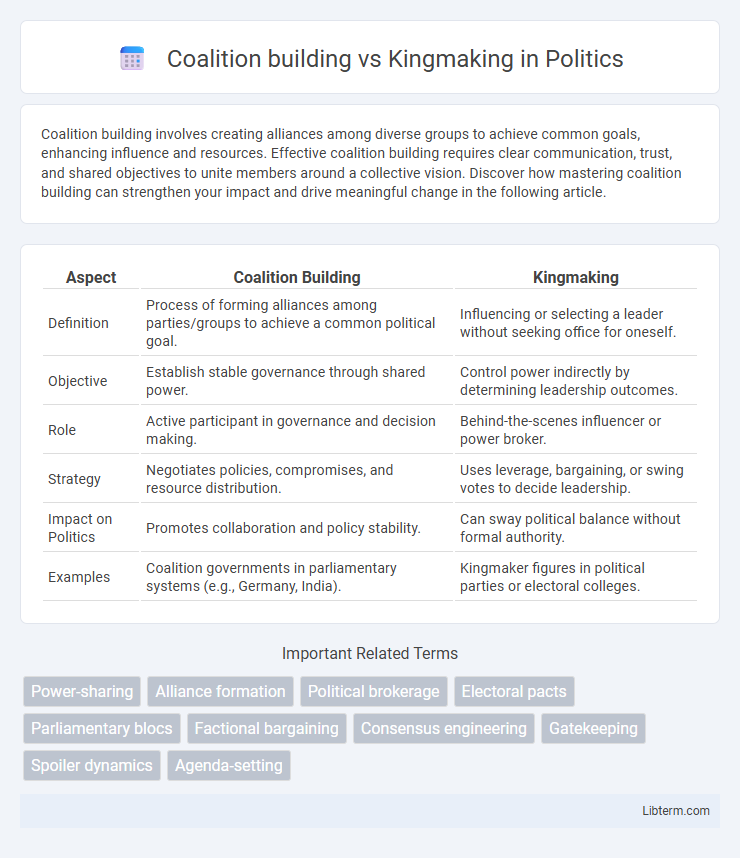Coalition building involves creating alliances among diverse groups to achieve common goals, enhancing influence and resources. Effective coalition building requires clear communication, trust, and shared objectives to unite members around a collective vision. Discover how mastering coalition building can strengthen your impact and drive meaningful change in the following article.
Table of Comparison
| Aspect | Coalition Building | Kingmaking |
|---|---|---|
| Definition | Process of forming alliances among parties/groups to achieve a common political goal. | Influencing or selecting a leader without seeking office for oneself. |
| Objective | Establish stable governance through shared power. | Control power indirectly by determining leadership outcomes. |
| Role | Active participant in governance and decision making. | Behind-the-scenes influencer or power broker. |
| Strategy | Negotiates policies, compromises, and resource distribution. | Uses leverage, bargaining, or swing votes to decide leadership. |
| Impact on Politics | Promotes collaboration and policy stability. | Can sway political balance without formal authority. |
| Examples | Coalition governments in parliamentary systems (e.g., Germany, India). | Kingmaker figures in political parties or electoral colleges. |
Understanding Coalition Building
Coalition building involves strategic alliance formation among multiple stakeholders to achieve shared goals, emphasizing negotiation, trust, and resource pooling. Unlike kingmaking, which centers on selecting or supporting a singular leader to gain influence, coalition building prioritizes collective decision-making and power distribution. Effective coalition building requires understanding diverse interests and fostering collaboration for sustainable political or organizational outcomes.
Defining Kingmaking in Politics
Kingmaking in politics refers to the powerful act of influencing or determining the outcome of leadership selection without necessarily holding office oneself. This process often involves behind-the-scenes negotiations, leveraging political capital, or mobilizing voter blocs to elevate a favored candidate. Unlike coalition building, which creates alliances for shared governance, kingmaking centers on shaping power dynamics by positioning a specific individual into a dominant role.
Key Differences Between Coalition Building and Kingmaking
Coalition building involves forming alliances among multiple parties to achieve common goals through shared power and mutual benefit, emphasizing collaboration and consensus. Kingmaking centers on a dominant entity or individual influencing or selecting a leader, often behind the scenes, to control power without holding formal authority themselves. The key differences lie in the participatory nature of coalition building versus the more directive, often unilateral influence characteristic of kingmaking.
Historical Examples of Coalition Building
Historical examples of coalition building demonstrate strategic alliances formed to achieve common political or military goals, such as the coalition of Allied Powers during World War II that combined resources to defeat Axis forces. The Congress of Vienna in 1815 showcased a successful coalition-building effort where European powers collaborated to restore balance after Napoleon's defeat. These examples highlight coalition building as a process emphasizing cooperation and shared objectives, unlike kingmaking which centers on elevating a single leader to power.
Notable Instances of Kingmaking
Notable instances of kingmaking include the role of the Whig Party in the 1836 U.S. presidential election when they supported William Henry Harrison to defeat Martin Van Buren. Another example is the BJP's support for Shiv Sena in Maharashtra, crucial in forming the state government despite not winning a majority outright. In parliamentary systems, kingmakers often hold the balance of power, influencing government formation without leading the coalition themselves.
Strategic Advantages of Forming Coalitions
Forming coalitions provides strategic advantages such as pooling resources, expanding influence, and increasing bargaining power in political or organizational contexts. Coalitions enable diverse groups to align their goals and create a unified front that can achieve objectives unattainable individually. This collaboration enhances decision-making capabilities and fosters stability by balancing competing interests more effectively than kingmaking, which often concentrates power in a single entity.
Risks Associated with Kingmaking
Kingmaking poses significant risks such as undermining democratic legitimacy by enabling a small group to manipulate outcomes behind the scenes, often sidelining broader voter preferences. Coalition building, while complex, fosters transparency and collective decision-making by encouraging negotiation and compromise among multiple stakeholders. Relying on kingmakers increases the potential for corruption, power imbalances, and destabilization of political institutions.
Impact on Political Stability
Coalition building fosters political stability by encouraging collaboration among diverse parties, resulting in balanced governance and policy continuity. In contrast, kingmaking often triggers instability as a single entity manipulates power dynamics to control outcomes, undermining democratic processes. Effective coalition-building mechanisms enhance long-term political cohesion and reduce the likelihood of abrupt governmental crises.
Coalition Building vs Kingmaking: Which Is More Effective?
Coalition building fosters collaborative decision-making by uniting diverse stakeholders around shared objectives, enhancing long-term stability and policy implementation. Kingmaking, centered on endorsing a single powerful leader, can produce swift influence but often risks political volatility and exclusion of key interests. Empirical studies suggest coalition building yields more sustainable governance outcomes compared to the typically short-lived impact of kingmaking strategies.
Future Trends in Political Power-Sharing
Coalition building increasingly relies on data-driven strategies and AI to optimize political alliances and voter alignment, enhancing adaptive power-sharing in diverse democracies. Kingmaking, traditionally dependent on behind-the-scenes influence from elite power brokers, faces challenges from transparency demands and decentralized governance structures enabled by blockchain technologies. Future trends suggest a shift towards more dynamic, participatory power-sharing models where coalition building integrates digital tools to balance influence, reducing reliance on singular kingmakers.
Coalition building Infographic

 libterm.com
libterm.com